Colombian vs Armenian Community Comparison
COMPARE
Colombian
Armenian
Social Comparison
Social Comparison
Colombians
Armenians
5,155
SOCIAL INDEX
49.1/ 100
SOCIAL RATING
184th/ 347
SOCIAL RANK
5,687
SOCIAL INDEX
54.4/ 100
SOCIAL RATING
170th/ 347
SOCIAL RANK
Armenian Integration in Colombian Communities
The statistical analysis conducted on geographies consisting of 278,370,209 people shows a mild negative correlation between the proportion of Armenians within Colombian communities in the United States with a correlation coefficient (R) of -0.308. On average, for every 1% (one percent) increase in Colombians within a typical geography, there is a decrease of 0.008% in Armenians. To illustrate, in a geography comprising of 100,000 individuals, a rise of 1,000 Colombians corresponds to a decrease of 7.6 Armenians.
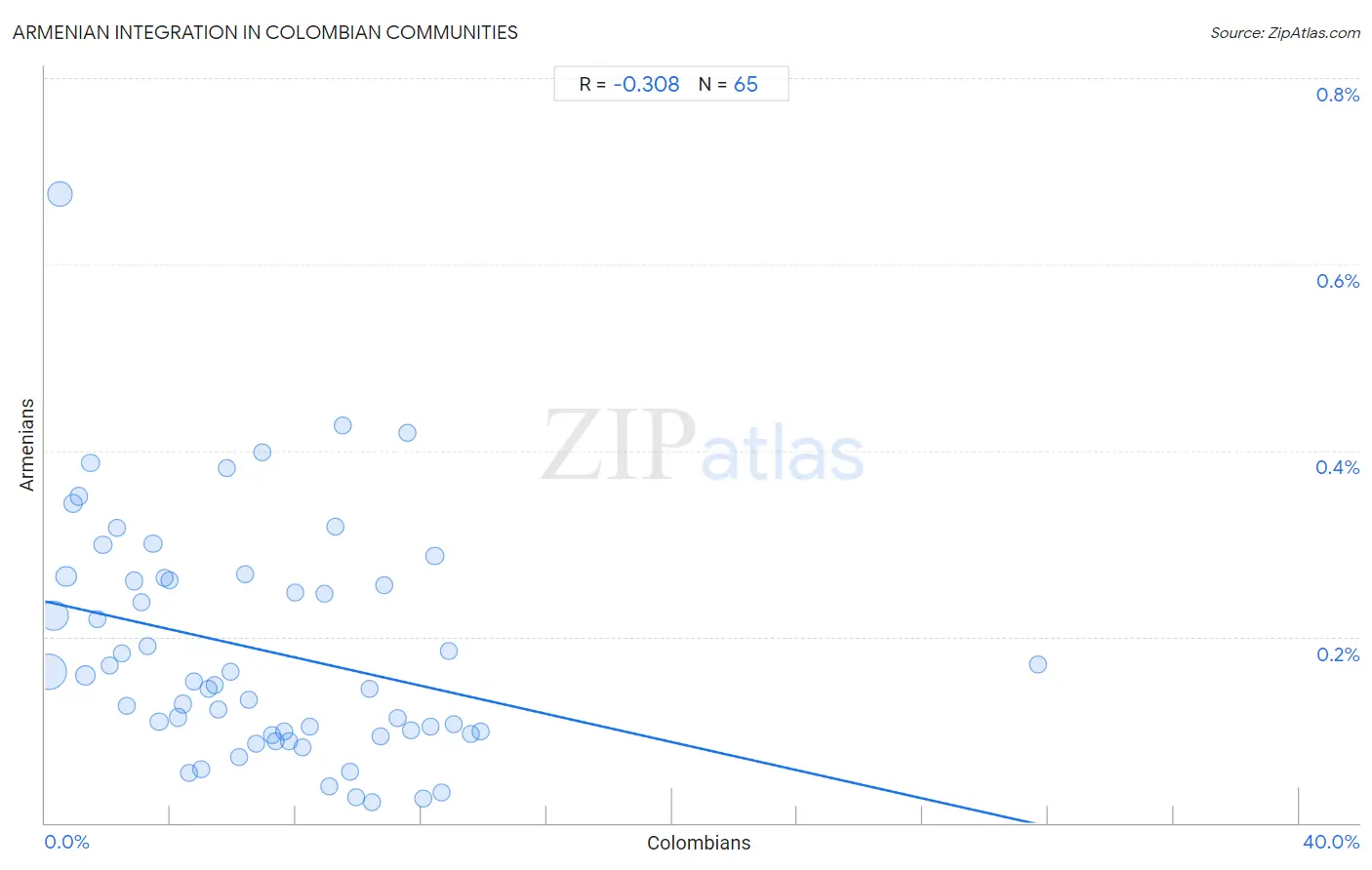
Colombian vs Armenian Income
When considering income, the most significant differences between Colombian and Armenian communities in the United States are seen in per capita income ($43,661 compared to $48,287, a difference of 10.6%), householder income ages 25 - 44 years ($94,565 compared to $103,248, a difference of 9.2%), and median family income ($100,750 compared to $109,692, a difference of 8.9%). Conversely, both communities are more comparable in terms of wage/income gap (24.7% compared to 24.8%, a difference of 0.24%), householder income under 25 years ($53,357 compared to $53,179, a difference of 0.33%), and householder income over 65 years ($58,851 compared to $61,656, a difference of 4.8%).

| Income Metric | Colombian | Armenian |
| Per Capita Income | Average $43,661 | Exceptional $48,287 |
| Median Family Income | Fair $100,750 | Exceptional $109,692 |
| Median Household Income | Average $85,716 | Exceptional $91,807 |
| Median Earnings | Average $46,349 | Exceptional $49,804 |
| Median Male Earnings | Fair $53,832 | Exceptional $58,134 |
| Median Female Earnings | Fair $39,439 | Exceptional $42,212 |
| Householder Age | Under 25 years | Exceptional $53,357 | Exceptional $53,179 |
| Householder Age | 25 - 44 years | Average $94,565 | Exceptional $103,248 |
| Householder Age | 45 - 64 years | Average $99,772 | Exceptional $107,002 |
| Householder Age | Over 65 years | Tragic $58,851 | Good $61,656 |
| Wage/Income Gap | Exceptional 24.7% | Exceptional 24.8% |
Colombian vs Armenian Poverty
When considering poverty, the most significant differences between Colombian and Armenian communities in the United States are seen in receiving food stamps (12.6% compared to 11.1%, a difference of 13.5%), single female poverty (19.9% compared to 18.3%, a difference of 8.7%), and female poverty among 25-34 year olds (13.2% compared to 12.2%, a difference of 8.4%). Conversely, both communities are more comparable in terms of seniors poverty over the age of 75 (14.3% compared to 14.2%, a difference of 0.36%), male poverty (11.0% compared to 11.0%, a difference of 0.56%), and single male poverty (12.2% compared to 12.1%, a difference of 0.74%).
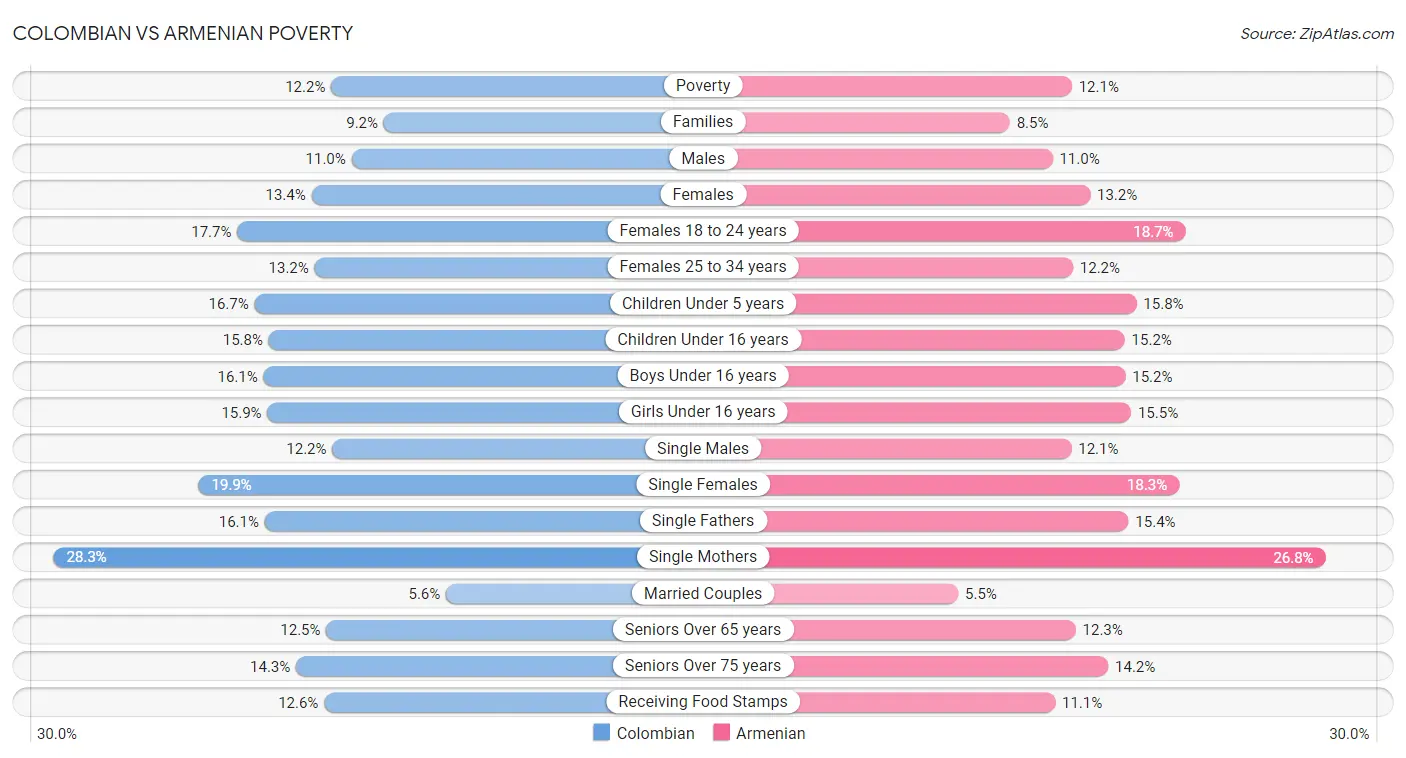
| Poverty Metric | Colombian | Armenian |
| Poverty | Average 12.2% | Good 12.1% |
| Families | Fair 9.2% | Excellent 8.5% |
| Males | Good 11.0% | Good 11.0% |
| Females | Average 13.4% | Good 13.2% |
| Females 18 to 24 years | Exceptional 17.7% | Exceptional 18.7% |
| Females 25 to 34 years | Good 13.2% | Exceptional 12.2% |
| Children Under 5 years | Good 16.7% | Exceptional 15.8% |
| Children Under 16 years | Good 15.8% | Excellent 15.2% |
| Boys Under 16 years | Good 16.1% | Exceptional 15.2% |
| Girls Under 16 years | Good 15.9% | Excellent 15.5% |
| Single Males | Exceptional 12.2% | Exceptional 12.1% |
| Single Females | Exceptional 19.9% | Exceptional 18.3% |
| Single Fathers | Good 16.1% | Exceptional 15.4% |
| Single Mothers | Exceptional 28.3% | Exceptional 26.8% |
| Married Couples | Tragic 5.6% | Poor 5.5% |
| Seniors Over 65 years | Tragic 12.5% | Tragic 12.3% |
| Seniors Over 75 years | Tragic 14.3% | Tragic 14.2% |
| Receiving Food Stamps | Poor 12.6% | Excellent 11.1% |
Colombian vs Armenian Unemployment
When considering unemployment, the most significant differences between Colombian and Armenian communities in the United States are seen in unemployment among seniors over 75 years (8.5% compared to 7.2%, a difference of 17.6%), unemployment among ages 25 to 29 years (6.6% compared to 7.7%, a difference of 16.9%), and male unemployment (5.2% compared to 6.0%, a difference of 15.9%). Conversely, both communities are more comparable in terms of unemployment among women with children under 18 years (5.6% compared to 5.7%, a difference of 3.2%), unemployment among women with children under 6 years (7.5% compared to 7.2%, a difference of 3.5%), and unemployment among seniors over 65 years (5.3% compared to 5.5%, a difference of 3.6%).
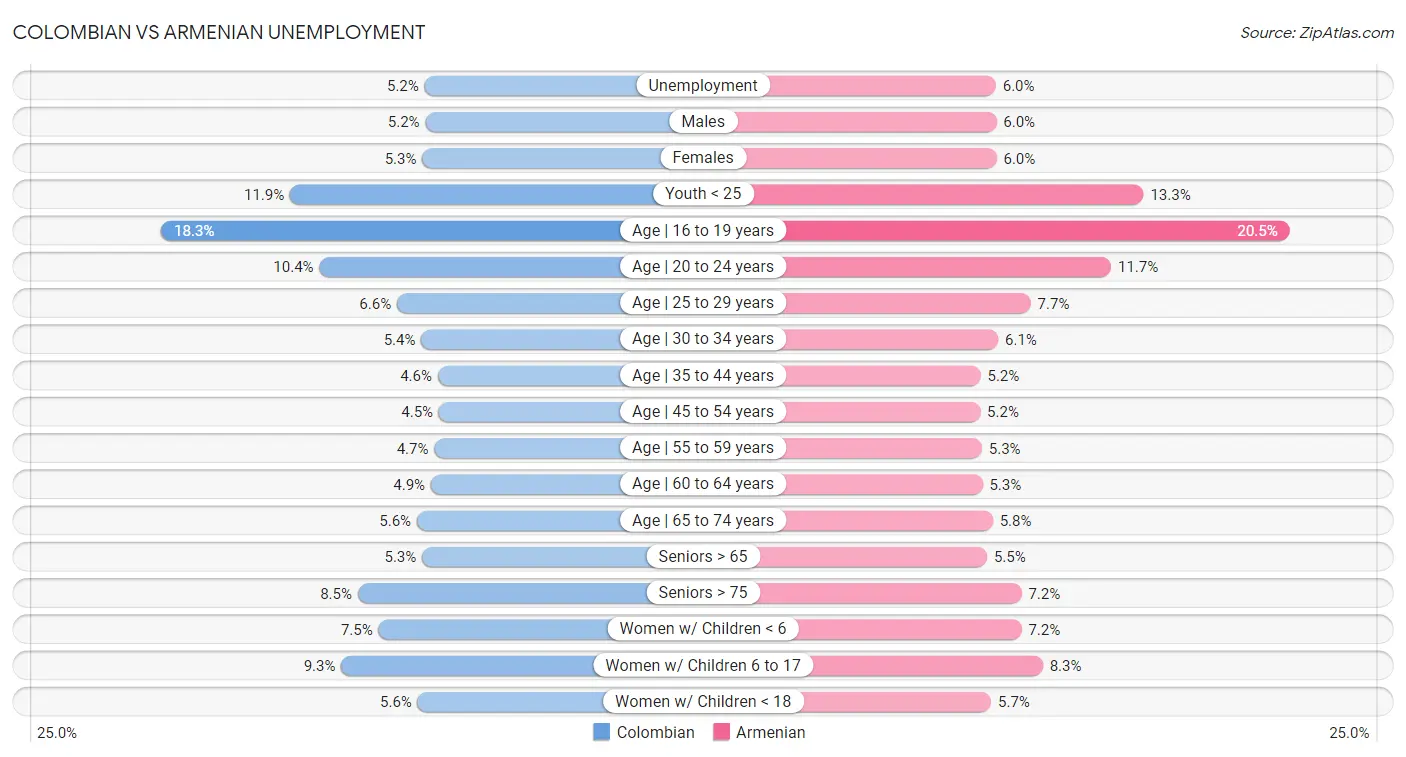
| Unemployment Metric | Colombian | Armenian |
| Unemployment | Good 5.2% | Tragic 6.0% |
| Males | Excellent 5.2% | Tragic 6.0% |
| Females | Fair 5.3% | Tragic 6.0% |
| Youth < 25 | Tragic 11.9% | Tragic 13.3% |
| Age | 16 to 19 years | Tragic 18.3% | Tragic 20.5% |
| Age | 20 to 24 years | Fair 10.4% | Tragic 11.7% |
| Age | 25 to 29 years | Good 6.6% | Tragic 7.7% |
| Age | 30 to 34 years | Good 5.4% | Tragic 6.1% |
| Age | 35 to 44 years | Excellent 4.6% | Tragic 5.2% |
| Age | 45 to 54 years | Average 4.5% | Tragic 5.2% |
| Age | 55 to 59 years | Excellent 4.7% | Tragic 5.3% |
| Age | 60 to 64 years | Fair 4.9% | Tragic 5.3% |
| Age | 65 to 74 years | Tragic 5.6% | Tragic 5.8% |
| Seniors > 65 | Tragic 5.3% | Tragic 5.5% |
| Seniors > 75 | Excellent 8.5% | Exceptional 7.2% |
| Women w/ Children < 6 | Good 7.5% | Exceptional 7.2% |
| Women w/ Children 6 to 17 | Tragic 9.3% | Exceptional 8.3% |
| Women w/ Children < 18 | Fair 5.6% | Tragic 5.7% |
Colombian vs Armenian Labor Participation
When considering labor participation, the most significant differences between Colombian and Armenian communities in the United States are seen in in labor force | age 16-19 (33.8% compared to 32.9%, a difference of 2.7%), in labor force | age > 16 (65.9% compared to 64.9%, a difference of 1.5%), and in labor force | age 20-24 (73.5% compared to 72.5%, a difference of 1.3%). Conversely, both communities are more comparable in terms of in labor force | age 25-29 (84.7% compared to 84.8%, a difference of 0.080%), in labor force | age 30-34 (84.9% compared to 85.0%, a difference of 0.16%), and in labor force | age 20-64 (80.1% compared to 79.5%, a difference of 0.79%).

| Labor Participation Metric | Colombian | Armenian |
| In Labor Force | Age > 16 | Exceptional 65.9% | Fair 64.9% |
| In Labor Force | Age 20-64 | Exceptional 80.1% | Average 79.5% |
| In Labor Force | Age 16-19 | Tragic 33.8% | Tragic 32.9% |
| In Labor Force | Age 20-24 | Tragic 73.5% | Tragic 72.5% |
| In Labor Force | Age 25-29 | Good 84.7% | Good 84.8% |
| In Labor Force | Age 30-34 | Excellent 84.9% | Exceptional 85.0% |
| In Labor Force | Age 35-44 | Exceptional 85.0% | Fair 84.3% |
| In Labor Force | Age 45-54 | Exceptional 83.4% | Fair 82.5% |
Colombian vs Armenian Family Structure
When considering family structure, the most significant differences between Colombian and Armenian communities in the United States are seen in single mother households (6.6% compared to 5.2%, a difference of 25.5%), births to unmarried women (32.2% compared to 26.2%, a difference of 23.0%), and divorced or separated (12.4% compared to 11.0%, a difference of 12.8%). Conversely, both communities are more comparable in terms of married-couple households (46.8% compared to 46.9%, a difference of 0.21%), average family size (3.26 compared to 3.25, a difference of 0.41%), and currently married (46.3% compared to 46.8%, a difference of 1.0%).

| Family Structure Metric | Colombian | Armenian |
| Family Households | Exceptional 66.3% | Average 64.4% |
| Family Households with Children | Exceptional 28.3% | Tragic 26.4% |
| Married-couple Households | Good 46.8% | Good 46.9% |
| Average Family Size | Excellent 3.26 | Good 3.25 |
| Single Father Households | Average 2.3% | Exceptional 2.1% |
| Single Mother Households | Poor 6.6% | Exceptional 5.2% |
| Currently Married | Fair 46.3% | Average 46.8% |
| Divorced or Separated | Tragic 12.4% | Exceptional 11.0% |
| Births to Unmarried Women | Fair 32.2% | Exceptional 26.2% |
Colombian vs Armenian Vehicle Availability
When considering vehicle availability, the most significant differences between Colombian and Armenian communities in the United States are seen in 4 or more vehicles in household (5.5% compared to 6.6%, a difference of 19.7%), 3 or more vehicles in household (17.8% compared to 19.8%, a difference of 11.3%), and no vehicles in household (10.0% compared to 9.4%, a difference of 7.1%). Conversely, both communities are more comparable in terms of 1 or more vehicles in household (88.0% compared to 90.7%, a difference of 3.0%), 2 or more vehicles in household (52.9% compared to 56.3%, a difference of 6.5%), and no vehicles in household (10.0% compared to 9.4%, a difference of 7.1%).

| Vehicle Availability Metric | Colombian | Armenian |
| No Vehicles Available | Good 10.0% | Exceptional 9.4% |
| 1+ Vehicles Available | Tragic 88.0% | Exceptional 90.7% |
| 2+ Vehicles Available | Tragic 52.9% | Excellent 56.3% |
| 3+ Vehicles Available | Tragic 17.8% | Good 19.8% |
| 4+ Vehicles Available | Tragic 5.5% | Excellent 6.6% |
Colombian vs Armenian Education Level
When considering education level, the most significant differences between Colombian and Armenian communities in the United States are seen in doctorate degree (1.7% compared to 2.1%, a difference of 22.4%), professional degree (4.6% compared to 5.3%, a difference of 15.9%), and bachelor's degree (38.4% compared to 42.3%, a difference of 10.1%). Conversely, both communities are more comparable in terms of 11th grade (91.7% compared to 91.7%, a difference of 0.010%), 10th grade (92.8% compared to 92.7%, a difference of 0.10%), and kindergarten (97.7% compared to 97.6%, a difference of 0.11%).
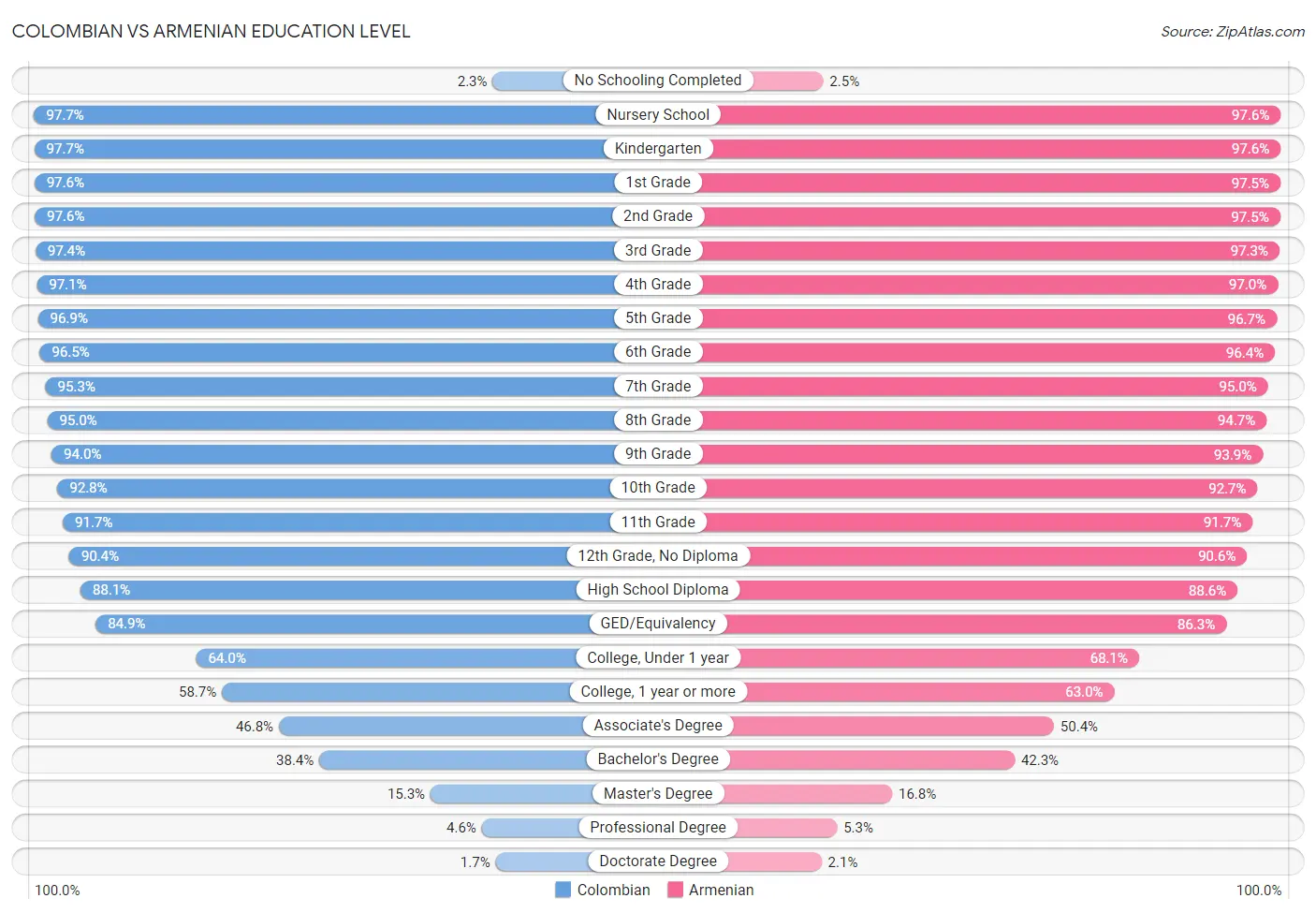
| Education Level Metric | Colombian | Armenian |
| No Schooling Completed | Tragic 2.3% | Tragic 2.5% |
| Nursery School | Tragic 97.7% | Tragic 97.6% |
| Kindergarten | Tragic 97.7% | Tragic 97.6% |
| 1st Grade | Tragic 97.6% | Tragic 97.5% |
| 2nd Grade | Tragic 97.6% | Tragic 97.5% |
| 3rd Grade | Tragic 97.4% | Tragic 97.3% |
| 4th Grade | Tragic 97.1% | Tragic 97.0% |
| 5th Grade | Tragic 96.9% | Tragic 96.7% |
| 6th Grade | Tragic 96.5% | Tragic 96.4% |
| 7th Grade | Tragic 95.3% | Tragic 95.0% |
| 8th Grade | Tragic 95.0% | Tragic 94.7% |
| 9th Grade | Tragic 94.0% | Tragic 93.9% |
| 10th Grade | Tragic 92.8% | Tragic 92.7% |
| 11th Grade | Tragic 91.7% | Tragic 91.7% |
| 12th Grade, No Diploma | Tragic 90.4% | Poor 90.6% |
| High School Diploma | Tragic 88.1% | Poor 88.6% |
| GED/Equivalency | Poor 84.9% | Good 86.3% |
| College, Under 1 year | Poor 64.0% | Exceptional 68.1% |
| College, 1 year or more | Fair 58.7% | Exceptional 63.0% |
| Associate's Degree | Good 46.8% | Exceptional 50.4% |
| Bachelor's Degree | Good 38.4% | Exceptional 42.3% |
| Master's Degree | Good 15.3% | Exceptional 16.8% |
| Professional Degree | Good 4.6% | Exceptional 5.3% |
| Doctorate Degree | Poor 1.7% | Exceptional 2.1% |
Colombian vs Armenian Disability
When considering disability, the most significant differences between Colombian and Armenian communities in the United States are seen in self-care disability (2.4% compared to 3.4%, a difference of 41.7%), disability age 5 to 17 (5.5% compared to 4.6%, a difference of 18.9%), and disability age under 5 (1.2% compared to 1.0%, a difference of 18.5%). Conversely, both communities are more comparable in terms of disability age 35 to 64 (9.9% compared to 9.9%, a difference of 0.10%), disability age 18 to 34 (5.9% compared to 5.8%, a difference of 0.81%), and cognitive disability (16.6% compared to 17.2%, a difference of 3.4%).
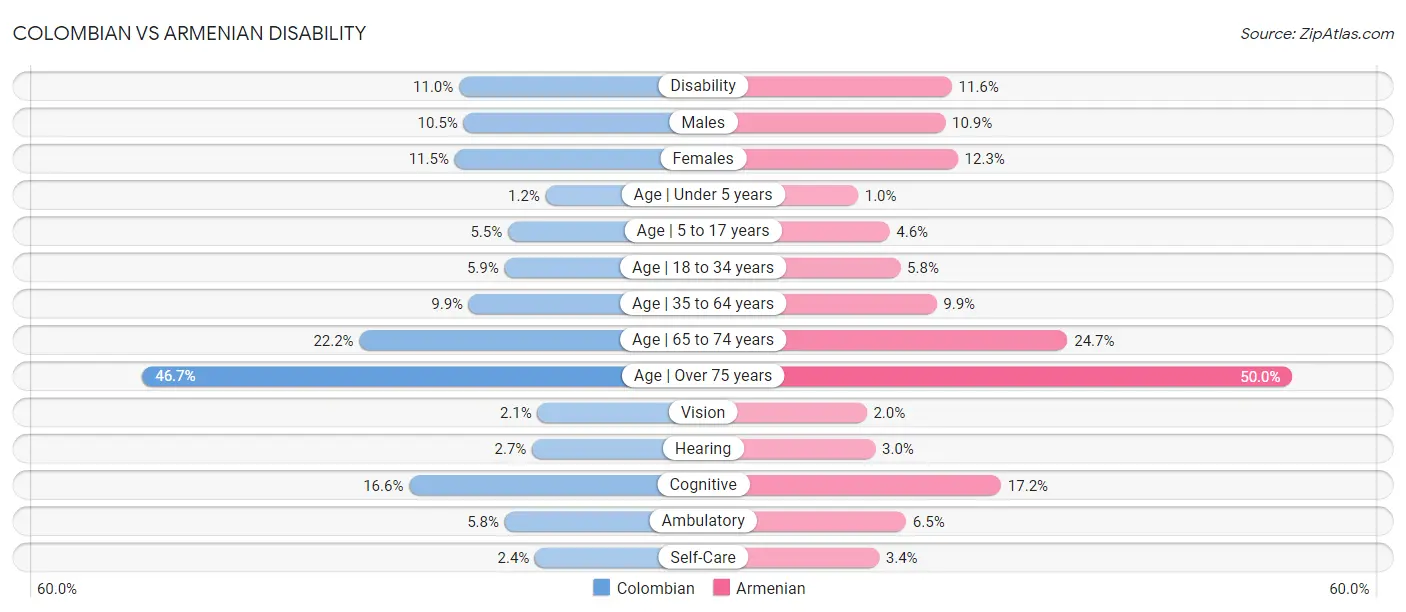
| Disability Metric | Colombian | Armenian |
| Disability | Exceptional 11.0% | Good 11.6% |
| Males | Exceptional 10.5% | Exceptional 10.9% |
| Females | Exceptional 11.5% | Fair 12.3% |
| Age | Under 5 years | Good 1.2% | Exceptional 1.0% |
| Age | 5 to 17 years | Excellent 5.5% | Exceptional 4.6% |
| Age | 18 to 34 years | Exceptional 5.9% | Exceptional 5.8% |
| Age | 35 to 64 years | Exceptional 9.9% | Exceptional 9.9% |
| Age | 65 to 74 years | Exceptional 22.2% | Tragic 24.7% |
| Age | Over 75 years | Exceptional 46.7% | Tragic 50.0% |
| Vision | Good 2.1% | Exceptional 2.0% |
| Hearing | Exceptional 2.7% | Average 3.0% |
| Cognitive | Exceptional 16.6% | Good 17.2% |
| Ambulatory | Exceptional 5.8% | Tragic 6.5% |
| Self-Care | Excellent 2.4% | Tragic 3.4% |